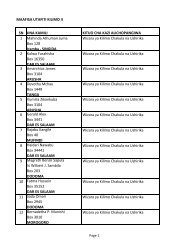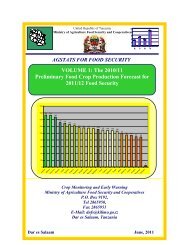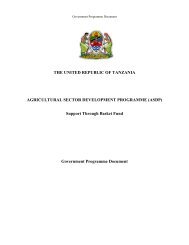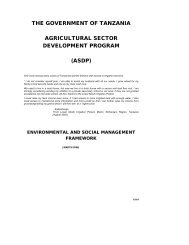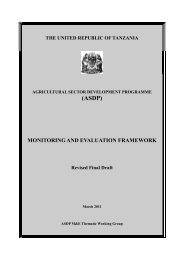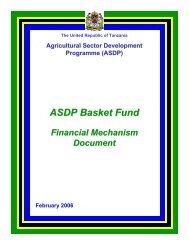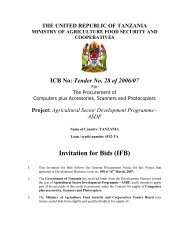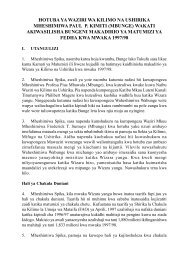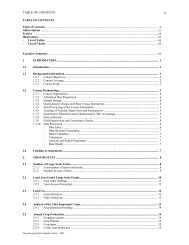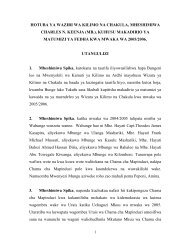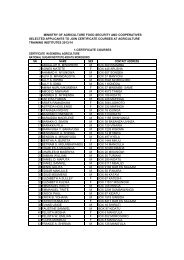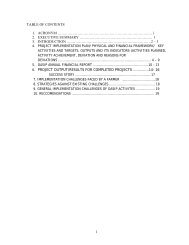Aide Memoire for the.. - Ministry Of Agriculture, Food and Cooperatives
Aide Memoire for the.. - Ministry Of Agriculture, Food and Cooperatives
Aide Memoire for the.. - Ministry Of Agriculture, Food and Cooperatives
Create successful ePaper yourself
Turn your PDF publications into a flip-book with our unique Google optimized e-Paper software.
THE UNITED REPUBLIC OF TANZANIA<br />
AGRICULTURAL SECTOR DEVELOPMENT PROGRAMME<br />
(ASDP)<br />
AIDE MEMOIRE FOR THE SECOND JOINT<br />
IMPLEMENTATION REVIEW<br />
19/10/2007 – 2/11/2007<br />
Final Draft
November 29, 2007<br />
Contents<br />
Introduction……………………………………………………………………………………...2<br />
Findings on Implementation <strong>and</strong> Progress on <strong>the</strong> Agreed Actions……………………………...4<br />
Summary of Recommendations <strong>and</strong> Way Forward………………………………………….....12<br />
Lesson Learned from <strong>the</strong> Review…………………………………………………………….....13<br />
Annex 1: Overall Terms of Reference Agricultural Sector Development Program (ASDP)<br />
Joint Implementation Review October 1 – 19, 200………………………………….14<br />
Annex 2: Table 1: Status of Agreed Actions from <strong>the</strong> first Joint Implementation Review…………....18<br />
Annex 3: Table 2: Agreed Actions <strong>and</strong> Way Forward <strong>for</strong> 2007/2008 Implementation<br />
Primary Actions: For <strong>the</strong> next Six Months………………………………………………..21<br />
Table 3: Agreed Actions <strong>and</strong> Way Forward <strong>for</strong> 2007/2008 Implementation<br />
Secondary Actions: Beyond Six Months……………………………………………………..24<br />
Annex 4: Basket Fund Disbursement Status <strong>for</strong> 2007/08 as of September 2007 (US $ '000)….26<br />
Annex 5: Summary of Visited Regions <strong>and</strong> LGAs……………………………………………………...27<br />
2
November 29, 2007<br />
Introduction:<br />
1. The first Joint Implementation Review of ASDP was carried out in April, 2007 by <strong>the</strong><br />
Government <strong>and</strong> ASDP Development Partners. The review focused on assessing progress made during<br />
<strong>the</strong> first year of implementation of <strong>the</strong> program <strong>and</strong> to identify specific actions that will facilitate<br />
implementation in <strong>the</strong> following six months.<br />
2. The main objective of <strong>the</strong> second Joint Implementation Review was to carry out a review of <strong>the</strong><br />
implementation progress of program activities over <strong>the</strong> last six months, since <strong>the</strong> first review.<br />
Specifically <strong>the</strong> JIR focused on: (i) monitoring implementation progress of <strong>the</strong> specific agreed actions<br />
needed to improve <strong>the</strong> implementation of ASDP, identified during <strong>the</strong> last review 1 <strong>and</strong> (ii) evaluate<br />
implementation progress of sub-components/<strong>the</strong>matic areas that were not adequately addressed in <strong>the</strong> first<br />
review, including, marketing/private sector development, irrigation, agricultural Services <strong>and</strong> food<br />
security <strong>and</strong> (iii) provide recommendations <strong>for</strong> future implementation of <strong>the</strong> program.. This Joint<br />
Implementation Review took a wider approach. As shown in Annex 5, a total of 10 regions <strong>and</strong> 22<br />
districts were visited. The review team also had discussions with directors of ASLMs <strong>and</strong> o<strong>the</strong>r staff at<br />
<strong>the</strong> national level. The review team comprised of representatives of <strong>the</strong> four Agricultural Sector Lead<br />
Ministries - ASLMs (MAFC, MLD, MITM <strong>and</strong> PMO-RALG), Development Partners (DPs: EU, IFAD,<br />
FAO, Japan, Irish Aid <strong>and</strong> World Bank) <strong>and</strong> o<strong>the</strong>r stakeholders. The IFAD <strong>and</strong> MAFC provided <strong>the</strong><br />
overall leadership <strong>and</strong> coordination of <strong>the</strong> review process on behalf of DPs <strong>and</strong> ASLMs respectively.<br />
3. The mission began with one day discussion in Dar es Salaam followed by one week field work by<br />
technical teams (Thematic Groups) organized around five specific <strong>the</strong>mes. The teams visited Rukwa,<br />
Mbeya, Iringa, Ruvuma, Tabora, Shinyanga, Arusha, Kilimanjaro <strong>and</strong> Dodoma regions. The ASLM<br />
directors <strong>and</strong> Development Partners visited Tanga region (H<strong>and</strong>eni <strong>and</strong> Muheza districts <strong>for</strong> two days).<br />
Annex 1 contains <strong>the</strong> overall TOR which guided <strong>the</strong> ASDP Review.<br />
4. The ASLMs <strong>and</strong> stakeholders assembled in Dar es Salaam on 2 nd November, 2007 in a wrap up<br />
meeting chaired by <strong>the</strong> PS (MAFC), Mr.Peniel M. Lyimo to discuss <strong>the</strong> findings <strong>and</strong> recommendations<br />
from <strong>the</strong> review.. The meeting was attended by high level decision makers of ASLMs, as well as some<br />
regional <strong>and</strong> district officials in areas visited. Members are listed in Annex 5 along with <strong>the</strong>ir<br />
organizations <strong>and</strong> respective regions <strong>and</strong> districts visited.<br />
Background<br />
5. The Agricultural Sector Development Program (ASDP) is <strong>the</strong> Government of Tanzania’s<br />
instrument <strong>for</strong> agricultural growth <strong>and</strong> poverty reduction as outlined in <strong>the</strong> Agricultural Sector<br />
Development Strategy (ASDS) <strong>and</strong> National Strategy <strong>for</strong> Growth <strong>and</strong> Reduction of Poverty<br />
(MKUKUTA). The Program has two objectives (i) to enable farmers to have better access to <strong>and</strong> use of<br />
agricultural knowledge, technologies, marketing systems <strong>and</strong> infrastructure, all of which contribute to<br />
higher productivity, profitability, <strong>and</strong> farm incomes; <strong>and</strong> (ii) to promote agricultural private investment<br />
based on an improved regulatory <strong>and</strong> policy environment.<br />
1 Status of <strong>the</strong> agreed actions of <strong>the</strong> first ASDP Implementation review can be found in Annex 2 including agreed<br />
action <strong>and</strong> way <strong>for</strong>ward <strong>for</strong> <strong>the</strong> second review.<br />
3
November 29, 2007<br />
6. These results are delivered through Local <strong>and</strong> National components. Local component activities<br />
are grounded in District Agricultural Development Plans (DADPs) <strong>and</strong> focus on three subcomponents: (i)<br />
local agricultural investments (including irrigation), (ii) local agricultural services, <strong>and</strong> (iii) local<br />
agricultural capacity building <strong>and</strong> re<strong>for</strong>m. National support focuses on five subcomponent areas: (i)<br />
re<strong>for</strong>ming agricultural services, primarily research <strong>and</strong> extension; (ii) improving <strong>the</strong> overall sector policy,<br />
regulatory <strong>and</strong> legal framework; marketing <strong>and</strong> private sector development; capacity building;<br />
in<strong>for</strong>mation <strong>and</strong> communication; (iii) investing in strategic national level irrigation infrastructure <strong>and</strong><br />
technical support <strong>for</strong> local level irrigation investment, <strong>and</strong> (iv) enhancing food security <strong>and</strong> (v)<br />
establishing a framework to ensure <strong>the</strong> quality <strong>and</strong> technical soundness of investments <strong>and</strong> delivery of<br />
services at local levels.<br />
7. Donor financing ASDP comes through a joint Basket Fund to which five donors have currently<br />
committed funds. 2 The Fund supports national activities via an agreed expenditure program <strong>for</strong> <strong>the</strong> four<br />
ASLMs with district <strong>and</strong> village level activities supported by per<strong>for</strong>mance based grants channeled<br />
through <strong>the</strong> Local Government Capital Development Grant (LGCDG) system coordinated by PMO-<br />
RALG.<br />
8. Given this context, <strong>the</strong> team was assigned to review <strong>and</strong> monitor <strong>the</strong> agreed actions during <strong>the</strong><br />
first review, assess progress made <strong>and</strong> addressing challenges in respective <strong>the</strong>matic areas, as well as<br />
Government’s implementation capacity <strong>and</strong> lessons from ongoing activities.<br />
Findings on Implementation <strong>and</strong> Progress on <strong>the</strong> Agreed actions.<br />
9. The findings below have been arranged according to <strong>the</strong> six <strong>the</strong>matic groups as stipulated in <strong>the</strong><br />
overall 3 TOR that guided <strong>the</strong> review. These findings indicate <strong>the</strong> overall implementation progress, status<br />
of agreed actions in <strong>the</strong> last review, challenges to ASDP implementation <strong>and</strong> additional actions necessary<br />
to enhance implementation progress. To achieve fur<strong>the</strong>r progress in <strong>the</strong> future, pro-active attention,<br />
commitment <strong>and</strong> timely actions to overcome challenges are necessary.<br />
10. Overall Status <strong>and</strong> Progress of Implementation<br />
Overall, <strong>the</strong>re is progress made in some areas over <strong>the</strong> last six months <strong>and</strong> it is still possible to achieve<br />
fur<strong>the</strong>r progress in order to achieve development objectives as set out in <strong>the</strong> ASDP programme document.<br />
The mission found that 14 out of <strong>the</strong> 26 agreed actions were completed, <strong>and</strong> 2 out of 14 are in progress. A<br />
detailed matrix of <strong>the</strong> status <strong>and</strong> progress of <strong>the</strong> agreed implementation actions of <strong>the</strong> April review can be<br />
found in Annex 2. Summary of implementation progress is outlined below:<br />
ASDP M&E Framework approved: The M&E Framework has been approved by Committee of Directors<br />
in July <strong>and</strong> a draft Terms of Reference <strong>for</strong> baseline data collection <strong>and</strong> tender has been prepared.<br />
Awareness of DADPs guidelines <strong>and</strong> DFTs (District Facilitation Teams) in place: Almost all districts<br />
visited reported that <strong>the</strong> DFTs are all aware of <strong>the</strong> DADPs guidelines <strong>and</strong> DADPs cycle of planning. All<br />
districts have DFTs in place<br />
2 Annex 4 contains basket fund disbursement status <strong>and</strong> commitments as of September 2007. This is being updated<br />
to reflect increased FY07/08 contributions from o<strong>the</strong>r participating donors that have partially compensated.<br />
3 Annex 1 contains <strong>the</strong> overall TOR which guided <strong>the</strong> ASDP Review. Each <strong>the</strong>matic group had its own TOR<br />
addressing specific <strong>the</strong>matic issues as well as monitoring <strong>the</strong> agreed actions in accordance with <strong>the</strong> first <strong>Aide</strong><br />
<strong>Memoire</strong><br />
4
November 29, 2007<br />
Progress has been made in improving planning <strong>and</strong> budgeting <strong>for</strong> ASDP over <strong>the</strong> past year. Key<br />
improvements include preparation of an integrated action plan <strong>and</strong> cash flow that extracts ASDP financed<br />
activities from within <strong>the</strong> MTEF <strong>and</strong> shows <strong>the</strong>m by department <strong>and</strong> by <strong>the</strong>matic area<br />
Thematic Working Groups have been <strong>for</strong>med <strong>and</strong> TORs on <strong>the</strong>ir functions have been shared with <strong>the</strong><br />
Development Partners. Currently, <strong>the</strong>re are 6 <strong>the</strong>matic working groups addressing different <strong>the</strong>mes under<br />
ASDP. They have fur<strong>the</strong>r developed an integrated workplan which has been extracted from <strong>the</strong> MTEF<br />
<strong>and</strong> will be used as a monitoring tool <strong>for</strong> <strong>the</strong> <strong>the</strong>matic groups.<br />
Irrigation: There has been a significant increase in <strong>the</strong> number of proposed new irrigation schemes from<br />
15 to 136 as of <strong>the</strong> time of <strong>the</strong> review. This signifies fur<strong>the</strong>r that <strong>the</strong> communities are well aligned with<br />
DADPs process.<br />
11. Common challenges of implementation<br />
DADPs guidelines: Despite massive awareness of guidelines in <strong>the</strong> LGAs, operationalization of <strong>the</strong><br />
guidelines by <strong>the</strong> DFTs remain a problem. This consequently affects to a great extent <strong>the</strong> quality of<br />
DADPs as most of <strong>the</strong>m do not adequately address rural poverty reduction, food security <strong>and</strong> hunger<br />
reduction initiatives.<br />
Late disbursement of funds has serious implications on most aspects of agricultural development.<br />
Improved disbursement linked with <strong>the</strong> agricultural cycle is required.<br />
Private sector involvement: The involvement of private sector remains a big challenge in <strong>the</strong> LGAs. This<br />
comes in two dimensions: <strong>the</strong> unwillingness to involve <strong>the</strong> sector as stakeholders in <strong>the</strong> planning <strong>and</strong><br />
implementation <strong>and</strong> <strong>the</strong> lack of knowledge on procuring private sector services<br />
Capacity Building: There is a need to increase capacity both human resource with required skills <strong>and</strong><br />
physical (machinery <strong>and</strong> equipments) at all levels. Specific capacity building components are included in<br />
each <strong>the</strong>me below. However, <strong>the</strong>re is a need to consolidate all capacity issues as a single area of activity.<br />
Staff <strong>and</strong> facilities: There is loss of institutional memory due to senior staff at national, zonal <strong>and</strong> LGA<br />
levels as majority are retiring <strong>and</strong> not being replaced, as well as obsolete facilities <strong>and</strong> equipment<br />
12. Key findings <strong>and</strong> challenges from <strong>the</strong> review are summarized below:<br />
Local Component<br />
13. The review teams held discussions during <strong>the</strong> field visits with LGAs, Regional Administrative<br />
Secretaries <strong>and</strong> Zonal Agricultural Research Institutes to assess implementation progress in respective<br />
<strong>the</strong>matic areas:<br />
• Agricultural planning <strong>and</strong> implementation<br />
• Irrigation<br />
• Agricultural services (research <strong>and</strong> extension)<br />
• Private Sector <strong>and</strong> marketing development<br />
• <strong>Food</strong> Security<br />
14. Agricultural planning <strong>and</strong> implementation:<br />
All visited districts have <strong>for</strong>med <strong>the</strong> District Facilitation Teams (DFTs) <strong>and</strong> Ward Facilitation Teams<br />
(WFTs), or are aware of <strong>the</strong> urgency <strong>and</strong> roles of <strong>the</strong>se teams in <strong>the</strong> planning process. This is considered<br />
5
November 29, 2007<br />
to be a good progress compared to <strong>the</strong> last review. Districts seem to be progressively conversant with <strong>the</strong><br />
program design <strong>and</strong> implementation arrangement. Also, most districts are aware of <strong>the</strong> participatory<br />
planning approach of DADPs through O&OD or PRA, even in cases where <strong>the</strong> approach has not been<br />
used <strong>for</strong> planning. Generally, all <strong>the</strong> districts visited have prepared DADPs. Involvement of <strong>the</strong> private<br />
sector is also in <strong>the</strong> process, to some extent 4 , even though it is still at its initial stage. Despite <strong>the</strong> observed<br />
progress <strong>the</strong> following key challenges were noted<br />
Generall challenges: Budget guidelines are not released on time to guide <strong>the</strong> planning process <strong>and</strong><br />
frequent changes of budget ceilings affect annual work plan <strong>and</strong> budget in most districts.<br />
DADPs Operational Setting: Despite <strong>the</strong> observed progress, <strong>the</strong> quality of DFTs <strong>and</strong> WFTs teams still<br />
needs to be improved through continued training <strong>and</strong> backstopping. The DADPs Guidelines (especially<br />
<strong>the</strong> Kiswahili version) should be widely distributed <strong>and</strong> ensure that all DFT/WFT members have copies<br />
<strong>and</strong> are en<strong>for</strong>ced by <strong>the</strong> PMO-RALG to use <strong>the</strong> guidelines <strong>for</strong> developing <strong>the</strong> DADPs.<br />
.<br />
Comprehensiveness of DADPs: The DADPs concept as a comprehensive plan is still unclear to most<br />
DFT members. Awareness at <strong>the</strong> community level is minimal. Some confusion still exist among LGAs in<br />
that DADPs is a project parallel to conventional ones such as PADEP or o<strong>the</strong>r donor-supported activities.<br />
DADPs Formulation Process <strong>and</strong> Strategic Quality: Generally, all <strong>the</strong> districts visited have prepared<br />
DADPs. However, <strong>the</strong> quality of DADPs is generally poor due to inadequate participatory <strong>and</strong> strategic<br />
planning process. The reasons include:<br />
• Strategic Planning: Though poorly prepared, almost all districts visited had developed strategic<br />
plans in place. However, <strong>the</strong>se strategies were not used during DADPs preparation. Criteria <strong>for</strong><br />
intervention selection are often <strong>the</strong> source of problems, size of beneficiaries, whe<strong>the</strong>r or not<br />
supported by o<strong>the</strong>r projects in <strong>the</strong> past, etc. Sometimes <strong>the</strong> level of ownership of communities is<br />
taken into consideration. There are cases where priorities are a priori instructed by higher<br />
authorities. In general, equity ra<strong>the</strong>r than efficiency seems to be of greater concern in <strong>the</strong> selection.<br />
• Use of Participatory Planning Methodologies: O&OD is yet to be rolled out in many LGAs. PRA<br />
was used in such LGAs to identify priorities of community level interventions. Never<strong>the</strong>less, <strong>the</strong>re<br />
is no evidence that <strong>the</strong> PRA or O&OD results have been used <strong>for</strong> DADPs preparation. During <strong>the</strong><br />
field visit, it was often confirmed that in an ordinary O&OD exercise, <strong>the</strong> issues of agricultural<br />
sector have not been sufficiently highlighted.<br />
• Stakeholder Involvement: Private sector inventory is in place in all LGAs, but <strong>the</strong>re is minimal<br />
involvement in <strong>the</strong> planning process. Involvement of private sector in provision of agricultural<br />
service is still a challenge.<br />
• MTEF planning <strong>for</strong>mat: All LGAs have not understood <strong>the</strong> three years planning concept as per <strong>the</strong><br />
MTEF, hence it was not used by some during planning.<br />
Allocation <strong>and</strong> Utilization of DADPs Conditional Grants: Review of DADPs documents <strong>and</strong> discussion<br />
with DFTs indicates <strong>the</strong> impression that <strong>the</strong>re is still low level of underst<strong>and</strong>ing on <strong>the</strong> use of ASDP<br />
grants especially <strong>the</strong> top-up part of <strong>the</strong> A-EBG <strong>and</strong> A-CBG. This has led to misallocation of <strong>the</strong> grants<br />
<strong>and</strong> hence potential risk of attaining expected outputs <strong>and</strong> outcomes. For instance, issues of contracting<br />
out, capacity building of private sector <strong>and</strong> farmer empowerment are not taken into account by some<br />
LGAs in <strong>the</strong> fund allocation.<br />
ASDP’s linkage to LGCDG <strong>and</strong> Reporting Systems: Generally, awareness of <strong>the</strong> reporting systems<br />
(PlanRep2, Epicor <strong>and</strong> LGMD) is fair in all LGAs, although majority of LGAs reported that <strong>the</strong> systems<br />
4 For example, Monduli DC requested plans from <strong>the</strong> private sector, <strong>and</strong> Mwanga DC has included <strong>the</strong> private sector rep in <strong>the</strong><br />
DFT.<br />
6
November 29, 2007<br />
are not user friendly. PlanRep is widely used in planning but not in progress reporting as this is not a<br />
reporting requirement by PMO-RALG. The PlanRep system is currently incompatible at different<br />
institutional levels <strong>and</strong> LGAs are facing difficulties during submission of plans to <strong>the</strong> <strong>Ministry</strong> of<br />
Finance. The LGAs are currently using <strong>for</strong>mats from <strong>the</strong> <strong>Ministry</strong> of Finance. Local Government<br />
Monitoring Database (LGMD) is known but not used by all LGAs. Epicor is equally not used due to<br />
inadequate technical capacity.<br />
Knowledge of <strong>the</strong> LGCDG system is still confined to a small group (DED, DPLO, <strong>and</strong> only sometimes<br />
DALDO) of LGA’s organization, leading that DALDO <strong>and</strong> DFT are barely knowledgeable of Minimum<br />
Conditions (MCs) <strong>and</strong> Per<strong>for</strong>mance Assessment (PA) of <strong>the</strong> system. Use of LGCDG account <strong>and</strong><br />
Development account <strong>for</strong> disbursement of ASDP grants is still not clear to most LGAs. Contrary to <strong>the</strong><br />
guidelines, some LGAs are still maintaining <strong>the</strong> DADPs account into which funds from LGCDG <strong>and</strong><br />
Development accounts are internally transferred.<br />
DADPs implementation: Late disbursement of funds affected implementation of 2006/07 action Plan. For<br />
most LGAs some activities planned <strong>for</strong> 2006/2007 (especially irrigation projects that are subjected to<br />
seasonality were shifted to <strong>the</strong> 1st quarter of FY 2007/08. Activities <strong>for</strong> 2006/07 were in some districts<br />
not identified through participatory process. All LGAs had not received DADPs funds (both basic <strong>and</strong> top<br />
up grant) <strong>for</strong> 2007/08. There<strong>for</strong>e development activities planned <strong>for</strong> 2007/08 had not started.<br />
In principle, <strong>the</strong> effective implementation of DADPs presupposes sufficient managerial capacity of<br />
communities (financial, organizational, reporting, <strong>and</strong> contracting abilities). This precondition also<br />
underlines <strong>the</strong> importance of farmer empowerment. However, many communities are still very much<br />
short of such capacity. The facilitation by LGAs is often constrained by <strong>the</strong> shortage of human <strong>and</strong><br />
financial resources. Such situation encourages <strong>the</strong> continuing practice of <strong>the</strong> conventional top-down<br />
approach, i.e. <strong>the</strong> LGAs construct facilities, supply materials (kits, seeds, chemicals, etc.), technical skills<br />
(trainers or exemplars), <strong>and</strong> show farmers to follow. There are cases where <strong>the</strong> communities were nei<strong>the</strong>r<br />
involved in <strong>the</strong> identification of projects nor implementation. This practice is inconsistent with <strong>the</strong> basic<br />
vision of ASDP: farmer empowerment <strong>and</strong> private sector promotion.<br />
Linkage with Regional Secretariat (RS): The regional secretariats described <strong>the</strong>ir roles as involving both<br />
supervisory <strong>and</strong> advisory functions, particularly regarding <strong>the</strong> preparation of DADPs. But with growing<br />
sense of LGAs being independent, toge<strong>the</strong>r with <strong>the</strong> limited human resources, <strong>the</strong> RS offices seem to feel<br />
less effective in influencing LGAs in <strong>the</strong>ir DADPs activities. Hence it would be necessary to consider<br />
carefully about <strong>the</strong> roles <strong>and</strong> duties of <strong>the</strong> RS office on <strong>the</strong> guidance (<strong>and</strong> technical backstopping) of<br />
LGAs <strong>for</strong> DADPs preparation <strong>and</strong> implementation, <strong>and</strong> <strong>the</strong> linkage between RS <strong>and</strong> PMO-RALG.<br />
Communication between LGAs <strong>and</strong> <strong>the</strong> Central Ministries: Districts officially submit <strong>the</strong>ir quarterly<br />
reports to PMO-RALG through <strong>the</strong> RS. In practice, <strong>the</strong> DALDO office often communicates directly to<br />
<strong>the</strong> PMO-RALG skipping RS office. The fact that consolidation of reports is done only partially at <strong>the</strong><br />
Regional level makes <strong>the</strong> work at PMO-RALG significantly laborious. Also sending reports from <strong>the</strong><br />
Region to PMO-RALG without copying to ASLMs also found to hampers smooth communication<br />
between Regions <strong>and</strong> <strong>the</strong> Central level.<br />
Linkage with Zonal Institutions: Research institutes are aware of ASDP <strong>and</strong> have received sensitisation.<br />
The ZARDEF committees were established. Some collaborations between LGAs <strong>and</strong> ZARDI through on<br />
farm research activities, seed multiplication <strong>and</strong> variety evaluation were observed, most arising from<br />
previous programs such as DADS <strong>and</strong> TARP II. Examples included cross ridging, testing new varieties<br />
of beans <strong>and</strong> intercropping with legumes. There was also ongoing collaboration with SUA, TaCRI, TRIT<br />
<strong>and</strong> international institutions. However, linkage with districts still needs to be streng<strong>the</strong>ned.<br />
7
November 29, 2007<br />
15. Irrigation:<br />
The review team observed some positive signs that <strong>the</strong> number of proposed new irrigation schemes has<br />
increased. As of May 2007, 15 requests <strong>for</strong> funding were submitted to <strong>the</strong> DIDF committee from 6<br />
districts, whereas in this financial year as of 30 th October 2007, 136 requests from 22 Districts have been<br />
received. However, <strong>the</strong> absolute number as proposed under ASDP-DIDF remains low. The following<br />
key challenges were identified:<br />
Level of incorporation of capacity building in irrigation scheme development: The level of incorporation<br />
of capacity building trainings in irrigation scheme development differs from one district to ano<strong>the</strong>r (In<br />
some districts farmers were trained at KATC, Moshi on water management <strong>and</strong> operation <strong>and</strong><br />
maintenance of irrigation schemes). Hence it should be encouraged that LGAs incorporate capacity<br />
building in <strong>the</strong>ir DADPs. In most cases farmers were in dem<strong>and</strong> of capacity building trainings .<br />
Existence <strong>and</strong> Effectiveness of Irrigators Organizations: It was observed that registration of irrigator’s<br />
organizations is not well defined in <strong>the</strong> project cycle. In some districts, <strong>the</strong> organizations are <strong>for</strong>med after<br />
<strong>the</strong> completion of construction of irrigation infrastructure, which normally results in <strong>the</strong> absence of sense<br />
of ownership by <strong>the</strong> farmers <strong>and</strong> consequently <strong>the</strong> projects ends up being unsustainable. There is a need to<br />
clearly define <strong>the</strong> advantages <strong>and</strong> disadvantages of <strong>for</strong>ming farmer’s organizations as ei<strong>the</strong>r associations<br />
or cooperative societies <strong>and</strong> to let farmers choose what <strong>the</strong>y prefer.<br />
Institutional Capacity <strong>and</strong> Willingness to Outsource: Most of <strong>the</strong> districts have on average 1 – 2<br />
irrigation technicians only, whereas some do not have any. There are very few districts with an<br />
irrigation/agricultural engineer. With this situation it is difficult to implement irrigation interventions in<br />
those districts. The utilization of <strong>the</strong> technical backstopping from <strong>the</strong> Zonal Irrigation <strong>and</strong> Technical<br />
Services Units (ZITSUs) needs to be streng<strong>the</strong>ned.<br />
Quality of Irrigation Development: It is observed that those districts which do not seek technical<br />
backstopping from <strong>the</strong> ZITSUs end up with slow progress <strong>and</strong> poor quality of irrigation<br />
systems/infrastructure. The team found that some of <strong>the</strong> system designs <strong>and</strong> implementation arrangements<br />
in <strong>the</strong> field were questionable. Currently <strong>the</strong>re are no legal regulations to be followed by irrigation<br />
development players pending <strong>the</strong> on-going <strong>for</strong>mulation of <strong>the</strong> National Irrigation Policy <strong>and</strong> Strategy.<br />
There is need <strong>for</strong> setting a mechanism <strong>for</strong> quality control during design, implementation <strong>and</strong> after<br />
completion.<br />
Environmental Issues in Irrigation Projects: The DFT recognizes issues of environment in irrigation<br />
development. However no environmental assessments have been conducted at any level. There is need to<br />
involve district environmental officers in all irrigation projects in districts.<br />
Capacity at National <strong>and</strong> Zonal Level: Although staff at <strong>the</strong> DITS <strong>and</strong> zonal level are qualified, still <strong>the</strong>re<br />
is need <strong>for</strong> <strong>the</strong>m to attend refresher courses on undertaking feasibility studies, designs <strong>and</strong> construction<br />
supervisions with contract management. The newly employed professionals will also benefit from such<br />
arrangements by putting <strong>the</strong>ir graduate knowledge to a more practical approach. With proper arrangement<br />
this can be done using MATI-Igurusi with outsourced experienced trainers, in possible collaboration with<br />
<strong>the</strong> National Construction Council (NCC).<br />
16. Agricultural services (research <strong>and</strong> extension):<br />
Agricultural Services in this aspect means both research <strong>and</strong> extension <strong>for</strong> both crops <strong>and</strong> livestock. The<br />
review team agrees that <strong>the</strong>re are significant activities <strong>and</strong> better environment <strong>for</strong> development of<br />
agricultural services in <strong>the</strong> LGAs. Linkages within districts were observed between district staff <strong>and</strong> ward<br />
<strong>and</strong> village farmers <strong>for</strong>a, particularly in <strong>the</strong> preparation of DADPs. While complaints were expressed by<br />
8
November 29, 2007<br />
some groups that farmer <strong>and</strong> village plans/projects loose priority at district level, o<strong>the</strong>rs were successful in<br />
having <strong>the</strong>irs included. Some top down projects were also observed <strong>and</strong> while <strong>the</strong>y were not <strong>the</strong> groups<br />
first choice, groups involved felt <strong>the</strong>y were very worthy. New innovations at village level included clonal<br />
coffee, banana, goats, improved chicken <strong>and</strong> pig keeping. Almost all villages were vaccinating <strong>for</strong><br />
newcastles disease.<br />
<strong>Agriculture</strong> services implementation is more advanced <strong>for</strong> extension than <strong>for</strong> research. Concerning<br />
extension, implementation is being helped by <strong>for</strong>mation of DFTs <strong>and</strong> WFTs that include extensionists,<br />
<strong>and</strong> identification of <strong>the</strong>ir role in technology transfer. While extensionists have yet to embrace <strong>the</strong>ir new<br />
role of facilitating <strong>for</strong>mation of farmer groups, <strong>the</strong> field team found farmer groups particularly FFS to be<br />
active in most LGAs visited, <strong>and</strong> noted that <strong>the</strong>y provide a promising plat<strong>for</strong>m <strong>for</strong> technology reception<br />
<strong>and</strong> dissemination as well as <strong>for</strong>mation of local networks (SACCOs, local marketing organizations).<br />
Some collaborations between LGAs <strong>and</strong> ZARDI through on farm research activities, seed multiplication<br />
<strong>and</strong> variety evaluation were observed, most arising from previous programs such as TARPII. Examples<br />
included cross ridging, testing new varieties of beans <strong>and</strong> intercropping with legumes. There was also<br />
ongoing collaboration with SUA, TaCRI, TRIT <strong>and</strong> international institutions.<br />
Major challenge is to support <strong>the</strong>se developments at LGA level in a coordinated way from <strong>the</strong> national<br />
level. There is also a need to focus on capacity building to enhance <strong>and</strong> sustain <strong>the</strong>se developments.<br />
Specific challenges include:<br />
Lack of capacity at district/ward/village levels: The review team noted <strong>the</strong> following capacity related<br />
issues at local level<br />
• Shortage of staff at ward <strong>and</strong> village level. Too few extension officers <strong>and</strong> many extension<br />
officers are serving more than one village<br />
• Technical capacity of WEOs/ VEOs to deliver both crop & livestock advice is weak.<br />
WEOs/VEOs are trained in ei<strong>the</strong>r livestock or crops. However many villages have both<br />
enterprises. It is difficult <strong>for</strong> an untrained crop extension officer to give advice on livestock <strong>and</strong><br />
vice a versa<br />
In adequate animal health service delivery: There is no enough veterinary diagnostic facilities <strong>and</strong><br />
equipment at district <strong>and</strong> ward levels. Diagnostic facilities particularly in <strong>the</strong> more rural areas are weak or<br />
absent. The private sector has not produced <strong>the</strong> expected take up <strong>and</strong> this has caused a vacuum. There is<br />
also a lack of manpower <strong>and</strong> shortage of drugs. East Coast Fever is still <strong>the</strong> major disease <strong>and</strong> little use of<br />
immunization leading to high levels of livestock mortality particularly calf mortality<br />
Slow roll-out of CORDEMA <strong>and</strong> ZARDEF in <strong>the</strong> ZARDI<br />
• The implementation of CORDEMA <strong>and</strong> establishment of ZARDEF as instruments <strong>for</strong> streng<strong>the</strong>ning<br />
<strong>the</strong> linkage between research <strong>and</strong> LGAs is lagging behind: ZARDI visited reported that researchers<br />
have participated in sensitisation workshops on CORDEMA <strong>and</strong> ZARDEF but lack knowledge <strong>and</strong><br />
guidelines on how ZARDEF <strong>and</strong> CORDEMA are going to operate. The institute has identified Zonal<br />
Technical Committee <strong>and</strong> Zonal Steering Committee <strong>for</strong> managing ZARDEF, training of <strong>the</strong> two<br />
committees is underway, as well as development of ZARDEF constitution. However, ZARDEF will<br />
not be operational in FY08/09 due to phased disbursement schedule proposed in <strong>the</strong> PIP. The team<br />
noted from <strong>the</strong> FY07/08 allocation that some ZARDIs will receive funds <strong>for</strong> ZARDEF in <strong>the</strong> fourth<br />
year of ASDP implementation. Also it was noted that <strong>the</strong> budget allocation <strong>for</strong> FY07/08 does not<br />
reflect <strong>the</strong> zonal research priorities.<br />
• There is loss of institutional memory due to senior researchers retiring <strong>and</strong> not being replaced. O<strong>the</strong>r<br />
challenges include obsolete facilities <strong>and</strong> equipment <strong>and</strong> lack of basic reagents <strong>and</strong> poor in<strong>for</strong>mation<br />
9
November 29, 2007<br />
flow to extension. The ZIELU staffing plan has not been implemented. This is a key linkage unit in<br />
ensuring that in<strong>for</strong>mation flows both upwards to <strong>the</strong> national level <strong>and</strong> downwards to farmers <strong>and</strong><br />
districts.<br />
Weak Linkage of Veterinary Investigation Centres (VICs) with research institutes <strong>and</strong> districts. There are<br />
no links between <strong>the</strong> VIC <strong>and</strong> <strong>the</strong> operation of <strong>the</strong> ZARDEF funds. The VIC is not represented on any<br />
ZARDEF committees <strong>and</strong> thus is unaware of <strong>the</strong>se activities. Similarly links between <strong>the</strong> VIC <strong>and</strong> district<br />
are weak. VICs do not receive timely, accurate <strong>and</strong> detailed in<strong>for</strong>mation from districts to enable <strong>the</strong>m to<br />
implement an effective disease surveillance system<br />
17. Marketing <strong>and</strong> Private Sector Development:<br />
Agricultural marketing is not well established <strong>and</strong> in most cases is undertaken in open spaces. Cross<br />
border trade is prominent due to Tanzania’s borders with DRC, Zambia, Ru<strong>and</strong>a, Burundi, Malawi,<br />
Kenya <strong>and</strong> Ug<strong>and</strong>a. The prevailing agricultural situation in <strong>the</strong>se countries affects <strong>the</strong> market in Tanzania.<br />
Many private traders supply inputs <strong>and</strong> buy produce from individual farmers. The availability of timely<br />
<strong>and</strong> accurate market in<strong>for</strong>mation on local, regional <strong>and</strong> cross border markets <strong>for</strong> both crops <strong>and</strong> livestock<br />
is critical in order to enable farmers <strong>and</strong> o<strong>the</strong>r stakeholders to make appropriate trading decisions.<br />
Marketing of crop products is being done successfully through participation of private-public<br />
involvement. However price trends are not controlled by farmers, who normally sell <strong>the</strong>ir produce to<br />
in<strong>for</strong>mal markets. There are agricultural selling centres (magulio) in districts, st<strong>and</strong>ard measurements are<br />
still normally used. And warehouse receipt is already popular in some districts. Some LGAs have<br />
empowered farmers by supporting <strong>the</strong>m through marketing groups <strong>and</strong> networks <strong>for</strong> <strong>the</strong>ir produce,<br />
especially cash crops e.g. coffee. This has improved access to in<strong>for</strong>mation, bargaining power <strong>and</strong> reduced<br />
transaction costs. Key challenges include:<br />
Poor Rural Infrastructure<br />
• Poor rural road networks. Long distances prevail between many towns <strong>and</strong> villages <strong>and</strong> some areas<br />
are not accessible during <strong>the</strong> rainy season.<br />
• Lack of market structures, warehouses <strong>and</strong> processing facilities. Many districts lack market<br />
structures <strong>and</strong> warehouse facilities. Many are also lacking processing facilities which can add<br />
value <strong>and</strong> extend shelf life.<br />
• Lack of knowledge on marketing issues. Farmers have limited access to market in<strong>for</strong>mation.<br />
The marketing process is complicated by <strong>the</strong> use of non-st<strong>and</strong>ardized weights <strong>and</strong> measures.<br />
• Lack of collective marketing. Most marketing is conducted by middlemen traders dealing<br />
directly with individual farmers. Few farmers sell in groups <strong>and</strong> thus have no collective<br />
marketing power.<br />
Inaccessibility to financial services: Financial services, particularly credit, <strong>for</strong> small farmers <strong>and</strong><br />
traders are necessary <strong>for</strong> successful marketing.<br />
18. <strong>Food</strong> Security:<br />
The food security team reviewed food security issues <strong>and</strong> assessed practicability of food security<br />
guidelines. LGAs are very much aware of ASDP. Despite <strong>the</strong> dry wea<strong>the</strong>r conditions of <strong>the</strong> places visited,<br />
<strong>the</strong> community cultivated a variety of food crops, using traditional irrigation ways, with food crops<br />
including tomatoes, onions, <strong>and</strong> leafy vegetables. The community is willing to contribute to development<br />
projects e.g. irrigation, dips. Key implementation challenges are summarized below:<br />
10
November 29, 2007<br />
<strong>Food</strong> preferences in some households have shown to affect utilization e.g. in <strong>the</strong> drier areas of Nor<strong>the</strong>rn<br />
zone, Tabora etc. farmers consider <strong>the</strong>mselves as food insecure because <strong>the</strong>y are not willing to accept<br />
sorghum as an appropriate alternative food crop <strong>for</strong> <strong>the</strong>ir area.<br />
There is lack of knowledge on improved food processing <strong>and</strong> preservation technologies: Hence <strong>the</strong><br />
farmers have to sell <strong>the</strong>ir produce immediately after harvest to avoid losses: a situation that creates food<br />
shortages <strong>and</strong> hence food insecurity even if <strong>the</strong> production was higher in <strong>the</strong>se areas. It was also noted<br />
that <strong>the</strong> available storage structures do not prevent crop losses.<br />
Identification of vulnerable groups: There was no clear system of identifying <strong>and</strong> supporting <strong>the</strong><br />
vulnerable groups such as old <strong>and</strong> sick people both at district level. The characteristics <strong>and</strong> behavior<br />
patterns of insecure communities were not understood, making hard to identify <strong>the</strong> possible projects to<br />
alleviate <strong>the</strong> situation.<br />
The effectiveness of early warning system (in<strong>for</strong>mation flow): The districts are not receiving in<strong>for</strong>mation<br />
on <strong>the</strong> risks of food insecurity in <strong>the</strong>ir areas in time. The knowledge <strong>and</strong> use of early warning system are<br />
not properly considered in preparation of DADPs. Fur<strong>the</strong>rmore, <strong>the</strong>re is lack of capacity at <strong>the</strong> district<br />
<strong>and</strong> ward levels to carry out vulnerability assessments to determine <strong>the</strong> magnitudes of <strong>the</strong> vulnerability in<br />
most areas.<br />
19. Cross Cutting issues:<br />
Findings reveal that <strong>the</strong>re have been adequate ef<strong>for</strong>ts to consider gender <strong>and</strong> HIV/AIDs issues in various<br />
processes related to <strong>the</strong> design <strong>and</strong> <strong>for</strong>mulation of <strong>the</strong> VADPs/DADPs respectively. However, noticeable<br />
variations were observed both within <strong>and</strong> across District Councils with respect to capacities <strong>for</strong><br />
integrating cross cutting issues in <strong>the</strong>ir respective DADPs <strong>and</strong> VADPs. This was caused possibly by<br />
inadequate or lack of capacities in gender analysis, gender planning, gender mainstreaming <strong>and</strong> or gender<br />
budgeting <strong>and</strong> gender statistics. Key challenges are summarized below:<br />
Lack of baseline indicators: Whilst <strong>the</strong> ASDP M&E framework have only been approved in July 2007<br />
<strong>and</strong> field testing of indicators is underway, <strong>the</strong> LGAs remain unknowledgeable on <strong>the</strong> proposed indicators<br />
<strong>and</strong> <strong>the</strong> use of baseline indicators hence<strong>for</strong>th. Due to this, <strong>the</strong> integration of cross cutting issues<br />
(HIV/AIDs, gender, environment <strong>and</strong> governance) in <strong>the</strong> monitoring <strong>and</strong> evaluation of ASDP will still be<br />
a challenge in <strong>the</strong> future.<br />
ASDP M&E Cross-cutting indicators: <strong>the</strong> indicators found in <strong>the</strong> M&E framework <strong>for</strong> crosscutting issues<br />
are ra<strong>the</strong>r few <strong>and</strong> not exhaustive considering <strong>the</strong> broadness of <strong>the</strong> sectoral programme. The indicators<br />
presented in <strong>the</strong> framework are thinly addressing cross cutting issues by merely raising awareness <strong>and</strong><br />
mostly leaving out implementation <strong>and</strong> mainstreaming of cross cutting interventions.<br />
National Component<br />
20. The team focused on <strong>the</strong> overall national implementation <strong>and</strong> monitoring of <strong>the</strong> programme,<br />
existing institutional set-up <strong>for</strong> coordinating ASDP, institutional linkages, planning <strong>and</strong> budgeting,<br />
participation <strong>and</strong> dialogue mechanism among stakeholders (Thematic Working Groups-TWGs), ASLMs,<br />
Committee of Directors, ASDP Secretariat, o<strong>the</strong>r ministries <strong>and</strong> non-public actors)<br />
Overall National Implementation <strong>and</strong> Monitoring: Overall, progress has been made on implementation<br />
<strong>and</strong> monitoring at <strong>the</strong> national level. The M&E framework that is supposed to be <strong>the</strong> monitoring tool <strong>for</strong><br />
<strong>the</strong> sector programme was developed by M&E TWG <strong>and</strong> approved by <strong>the</strong> Committee of Directors, <strong>and</strong><br />
<strong>the</strong>re are plans <strong>for</strong> development of guidelines <strong>and</strong> dissemination. Progress reports <strong>for</strong> <strong>the</strong> 3 rd <strong>and</strong> 4 th<br />
11
November 29, 2007<br />
quarter of 06/07 are available. Work is still underway to prepare quarterly reports <strong>for</strong> <strong>the</strong> 1 st quarter of<br />
07/08.<br />
Planning <strong>and</strong> budgeting: Progress has been made on improving planning <strong>and</strong> budgeting <strong>for</strong> ASDP over<br />
<strong>the</strong> past year. Key improvements have been <strong>the</strong> production of an integrated action plan <strong>and</strong> cash flow that<br />
extracts ASDP financed activities from within <strong>the</strong> MTEF <strong>and</strong> shows <strong>the</strong>m by department <strong>and</strong> by <strong>the</strong>matic<br />
area. None<strong>the</strong>less, approval <strong>and</strong> release of funds still remains behind schedule. Due to <strong>the</strong> late approval of<br />
<strong>the</strong> work plan <strong>and</strong> budget <strong>and</strong> lack of sufficient funds in <strong>the</strong> Basket Holding Account, funds <strong>for</strong> national<br />
level activities during <strong>the</strong> first quarter were not available. Most ASDP financed activities at <strong>the</strong> local <strong>and</strong><br />
national levels will only take place starting in late second quarter 2007/08.<br />
Institutional Linkages <strong>and</strong> Coordination: Improvement in coordination at national level was suggested in<br />
<strong>the</strong> first JIR. Since <strong>the</strong>n some adjustments have been made to improve coordination through <strong>the</strong> creation<br />
of TWGs. The TWGs submit <strong>the</strong> action plans to <strong>the</strong> DADP Planning <strong>and</strong> Implementation TWG who<br />
prepares an integrated work plan <strong>and</strong> it is <strong>the</strong>ir responsibility to ensure implementation of <strong>the</strong> integrated<br />
work plan. The chairs of <strong>the</strong> TWGs must commit to support <strong>the</strong> implementation of <strong>the</strong> integrated work<br />
plan. O<strong>the</strong>r ef<strong>for</strong>ts to improve ASDP coordination have also been made but effective coordination <strong>and</strong><br />
clarity of roles <strong>and</strong> relationship of ASDP Secretariat, DPP-MAFC <strong>and</strong> TWGs<br />
Summary of Recommendations <strong>and</strong> Way Forward<br />
21. This part summarizes <strong>the</strong> recommendations made by <strong>the</strong> <strong>the</strong>matic working groups on <strong>the</strong> findings<br />
of <strong>the</strong> review. Generally, progress has been made since <strong>the</strong> first implementation review in April, 2007.<br />
However, challenges still exist in <strong>the</strong> implementation of <strong>the</strong> ASDP. To overcome <strong>the</strong>se, <strong>the</strong> following has<br />
been recommended by <strong>the</strong> review team. (A detailed matrix on recommended actions <strong>and</strong> time frame <strong>for</strong><br />
implementing <strong>the</strong>m can be found in Annex 3, Table 2 <strong>and</strong> 3)<br />
Training <strong>and</strong> backstopping of quality DADPs with an emphasis on <strong>the</strong> MTEF three year roll out plan,<br />
O&OD, ASDP grants <strong>and</strong> <strong>the</strong>ir application, reporting <strong>and</strong> prioritization of DADPs should continue as<br />
earlier planned. This will help improve data systems to better track activities under <strong>the</strong> programme.<br />
Fur<strong>the</strong>r streng<strong>the</strong>ning of ASDP coordination: The review has found that fur<strong>the</strong>r ef<strong>for</strong>ts are needed in<br />
streng<strong>the</strong>ning coordination among ASLMs by improving skills, equipment <strong>and</strong> by recruitment of new<br />
staff, in particular streng<strong>the</strong>ning <strong>the</strong> capacity of DPP of ASLMs <strong>and</strong> <strong>the</strong> Agricultural Support Unit of<br />
PMO-RALG are urgently required <strong>for</strong> better communication. Also needed is <strong>the</strong> fur<strong>the</strong>r improvement of<br />
<strong>the</strong> functions of <strong>the</strong> Thematic Working Groups through revision of <strong>the</strong>ir Terms of References.<br />
There is a need to review guidelines on private sector engagement in marketing <strong>and</strong> establish an<br />
inventory of existing capacity, provide incentives <strong>for</strong> marketing infrastructure development <strong>and</strong><br />
in<strong>for</strong>mation, contracting out delivery of services, <strong>and</strong> establish criteria <strong>for</strong> accreditation of service<br />
providers. On <strong>the</strong> coverage of private sector actors <strong>and</strong> o<strong>the</strong>r stakeholders including government, a joint<br />
sensitization program on roles <strong>and</strong> functions under PPP should be emphasized <strong>and</strong> made clear.<br />
Capacity gaps both human <strong>and</strong> physical continue to exist at all levels. To achieve <strong>the</strong> outputs of <strong>the</strong><br />
program <strong>and</strong> realize <strong>the</strong> outcomes of MKUKUTA, skill gaps should be thoroughly <strong>and</strong> immediately<br />
addressed to take ASDP to <strong>the</strong> next level. In this regard, capacity need assessment should be undertaken<br />
by improving on <strong>the</strong> previous capacity study done.<br />
Streng<strong>the</strong>ning <strong>the</strong> role of <strong>the</strong>matic working groups by harmonizing interventions in MTEF across various<br />
stakeholders <strong>and</strong> ensuring no overlapping of actions <strong>and</strong> key strategic areas are covered. Providing<br />
targeted support activities to support implementation (such as <strong>the</strong> development of guidelines).<br />
12
November 29, 2007<br />
Additionally TWGs should assist in facilitating joint planning as required. However, it should be noted<br />
that <strong>the</strong> integrated TWG work plan should only be used to check <strong>the</strong> overlapping of interventions across<br />
sector-ministries <strong>and</strong> identifying gaps by <strong>the</strong>me, <strong>and</strong> not <strong>for</strong> monitoring as stipulated in <strong>Aide</strong> <strong>Memoire</strong> of<br />
<strong>the</strong> first JIR, April 2007.<br />
Cross-cutting issues: This JIR has had a Gender specialist <strong>for</strong> <strong>the</strong> first time. However, data collected <strong>and</strong><br />
<strong>the</strong> baseline indicators set during <strong>the</strong> review was not sufficient to evaluate <strong>the</strong> integration of cross cutting<br />
issues into ASDP implementation. More support on integrating <strong>and</strong> mainstreaming cross cutting issues<br />
into <strong>the</strong> program implementation is needed.<br />
Lesson learned from <strong>the</strong> Review<br />
22. This part covers <strong>the</strong> lessons learnt from <strong>the</strong> time of planning <strong>and</strong> arranging <strong>for</strong> <strong>the</strong> review to <strong>the</strong><br />
wrap up meeting. Some of <strong>the</strong> key lessons learnt <strong>and</strong> that should be taken up <strong>for</strong> <strong>the</strong> third implementation<br />
review are summarized below:<br />
• Organize <strong>the</strong> event much earlier.<br />
• Timeframe was too tight <strong>for</strong> field visits <strong>and</strong> report preparation.<br />
• The presence of a management team <strong>for</strong> <strong>the</strong> entire exercise was positive <strong>and</strong> should be continued.<br />
• Inputs from <strong>the</strong> <strong>the</strong>matic working group have been very helpful, <strong>and</strong> should be continued.<br />
• Supply materials (including Aid <strong>Memoire</strong>) earlier <strong>for</strong> better discussion <strong>and</strong> common<br />
underst<strong>and</strong>ing of issues, agreed actions <strong>and</strong> way <strong>for</strong>ward.<br />
13
November 29, 2007<br />
ANNEX 1<br />
Overall Terms of Reference<br />
Agricultural Sector Development Program (ASDP)<br />
Joint Implementation Review<br />
October 1 – 19, 2007<br />
Final<br />
Thursday September 14, 2007<br />
Background<br />
The <strong>Agriculture</strong> Sector Development Program (ASDP) is <strong>the</strong> Government of Tanzania’s instrument <strong>for</strong><br />
agricultural growth <strong>and</strong> poverty reduction as outlined in <strong>the</strong> <strong>Agriculture</strong> Sector Development Strategy (ASDS) <strong>and</strong><br />
Poverty Reduction Strategy (MKUKUTA). The Program’s two objectives are, first is to increase farm profitability<br />
<strong>and</strong> incomes through access to better technology, advice, <strong>and</strong> markets. Secondly, is to increase private sector<br />
investment agriculture based on an improved regulatory <strong>and</strong> Policy Environment.<br />
The ASDP is financed by a multi-donor basket fund that finances national activities via an agreed<br />
expenditure program <strong>for</strong> four <strong>Agriculture</strong> Sector Lead Ministries, (ASLMs) as well as district <strong>and</strong> village level<br />
activities via per<strong>for</strong>mance based grants channeled through <strong>the</strong> Local Government Capital Development Grant<br />
(LGCDG) system. These latter grants support on-farm investments including irrigation, agricultural service delivery,<br />
<strong>and</strong> capacity building.<br />
The ASDP implementation is now one year since its commencement in July 2006. Activities included<br />
awareness creation <strong>and</strong> a first round of training <strong>for</strong> districts in District Agricultural Development Plans (DADPs)<br />
This has been followed up by back-stopping activities to support fur<strong>the</strong>r training of District Facilitation Teams<br />
(DFTs) <strong>and</strong> Ward Facilitation Teams (WFTs). The experience was on <strong>the</strong> whole very positive, <strong>and</strong> demonstrated <strong>the</strong><br />
ability of ASLM (<strong>Agriculture</strong> Sector Lead <strong>Ministry</strong>) task teams, working across sectors <strong>and</strong> departments, to support<br />
DADP roll-out.<br />
2.0 Objectives<br />
The first Joint Implementation Review was carried out in April, 2007 by <strong>the</strong> Government <strong>and</strong> ASDP Development<br />
Partners in collaboration with o<strong>the</strong>r stakeholders. The second JIR will specifically focus on monitoring <strong>the</strong> agreed<br />
actions of <strong>the</strong> <strong>Aide</strong> <strong>Memoire</strong> <strong>and</strong> on some areas that were not adequately addressed in <strong>the</strong> first review (e.g.<br />
marketing/private sector development, irrigation, <strong>Agriculture</strong> Services <strong>and</strong> food security). The main objectives are:<br />
o<br />
o<br />
o<br />
o<br />
To assess <strong>the</strong> Program progress against set objectives <strong>and</strong> Targets,<br />
To evaluate <strong>and</strong> review <strong>the</strong> status of marketing <strong>and</strong> private sector development, irrigation, <strong>Agriculture</strong><br />
services <strong>and</strong> food security,<br />
To monitor <strong>the</strong> implementation of agreed actions <strong>and</strong><br />
To learn <strong>for</strong> future implementation.<br />
The review will both draw on <strong>and</strong> provide input to ongoing Government-lead processes <strong>for</strong> sector monitoring,<br />
decision making, <strong>and</strong> evaluation. The most prominent of <strong>the</strong>se are:<br />
o<br />
o<br />
o<br />
Quarterly meetings of <strong>the</strong> ASDP Basket Fund Steering Committee, which recommend disbursements<br />
from <strong>the</strong> ASDP Holding Account based on <strong>the</strong> Government’s quarterly reports monitoring ASDP<br />
physical <strong>and</strong> financial progress, at both national <strong>and</strong> LGA levels<br />
Budget cycle activities, including ASLM <strong>and</strong> LGA <strong>for</strong>mulation of work plans <strong>for</strong> agriculture related<br />
activities; budget preparation; budget execution <strong>and</strong> reporting; <strong>and</strong> reporting on work plan outputs<br />
Yearly agriculture sector review <strong>and</strong> public expenditure review<br />
Considering <strong>the</strong> broadness of <strong>the</strong> first review <strong>and</strong> that ASDP is a year into implementation, activities in <strong>the</strong> Review<br />
can usefully be organized around five specific <strong>the</strong>mes. These are:<br />
o Irrigation<br />
o <strong>Food</strong> Security<br />
14
November 29, 2007<br />
o<br />
o<br />
o<br />
o<br />
Services (Research <strong>and</strong> Extension) <strong>for</strong> crops <strong>and</strong> livestock<br />
Marketing <strong>and</strong> Private sector development<br />
Planning <strong>and</strong> Implementation<br />
Monitoring <strong>and</strong> Evaluation<br />
Some activities which are directly relevant to <strong>the</strong> Review will be carried out prior to <strong>the</strong> mission, <strong>and</strong> will provide<br />
direct input to it. These include <strong>the</strong> <strong>Agriculture</strong> Sector Review <strong>and</strong> Public Expenditure Review which will be<br />
finalized by end of September, as well as outputs from an ASDP M&E <strong>the</strong>matic working group recommendations<br />
on M&E framework.<br />
At national level public financial management <strong>and</strong> institutional issues would be addressed by a smaller team.<br />
3.0 Mission schedule: October 1 – October 19, 2007<br />
3.1 Overview<br />
The mission will start with one day of technical discussions in Dar es Salaam, including internal group discussions,<br />
meetings with ASLM technical specialists, <strong>and</strong> a plenary discussion with ASLM decision makers. As outlined in<br />
<strong>the</strong> calendar below, this will be followed by seven days of travel <strong>and</strong> field work. The mission on return to Dar es<br />
Salaam will have ano<strong>the</strong>r three days <strong>for</strong> discussion on what is needed to be done to speed up implementation of<br />
ASDP. The Discussions will focus on four main groups namely:-<br />
• Irrigation<br />
• Planning <strong>and</strong> implementation<br />
• Services<br />
• Marketing <strong>and</strong> Private sector development.<br />
The consultants will facilitate <strong>the</strong>se discussions.<br />
The mission will finish with four working days to consolidate <strong>and</strong> write up field trip experiences, complete <strong>the</strong><br />
<strong>Aide</strong>-<strong>Memoire</strong> (AM) <strong>and</strong> circulate to <strong>the</strong> ICC (Inter-Ministerial Coordinating Committee). A wrap-up meeting with<br />
<strong>the</strong> ICC will be held on October 19, at which findings will be discussed <strong>and</strong> agreed actions finalized. For easy of<br />
reference, this schedule of activities is laid out in <strong>the</strong> calendar below <strong>and</strong> mission schedule.<br />
Misión Schedule: October, 2007<br />
Activity<br />
Opening plenary<br />
Irrigation<br />
Services<br />
Marketing/PSD<br />
Planning/Implementation<br />
1st<br />
October<br />
2 – 7<br />
Oct<br />
8– 12<br />
Oct<br />
15<br />
Oct<br />
16 17 18 19 22 – 26<br />
Oct<br />
<strong>Food</strong> Security<br />
M & E<br />
Nat Fin Mgt<br />
Nat. Inst Issues<br />
Plenary session on field trips (Four<br />
Main Groups)<br />
Dir/DP field trip<br />
Prep AM<br />
Wrap-up<br />
Finalize AM - MoF<br />
15
November 29, 2007<br />
3. Activities<br />
A Management/Core team of GoT <strong>and</strong> DP representatives will be responsible <strong>for</strong> planning <strong>and</strong> co-ordination of <strong>the</strong><br />
review, assignment of tasks to sub teams <strong>and</strong> logistics, including schedule, time-table, field visit, <strong>and</strong> arrangement of<br />
plenary meetings. This team includes Mr. Emmanuel Achayo (MAFC) <strong>and</strong> Mwatima Juma (IFAD) as team leaders<br />
<strong>for</strong> GOT <strong>and</strong> DPs, respectively, Sophia Mlote (MLD), Julian Gutta (MITM), Aziza Mumba (PMO-RALG) <strong>and</strong><br />
Jacqueline Machangu (FAO).<br />
Each Thematic Working Group will have its own specific Terms of Reference that have been prepared in<br />
collaboration with <strong>the</strong> respective Thematic Working Group. The planning <strong>and</strong> implementation group would address<br />
among o<strong>the</strong>r things, <strong>the</strong> agreed actions raised during <strong>the</strong> last implementation review.<br />
Each of <strong>the</strong>se groups will complete a two week technical assignment at both field <strong>and</strong> national level be<strong>for</strong>e start of<br />
<strong>the</strong> overall review. Groups will visit geographic areas that will in<strong>for</strong>m <strong>the</strong>ir particular <strong>the</strong>me. The groups will be<br />
small groups of GoT <strong>and</strong> one or two consultants <strong>and</strong> any DP with specific expertise that would commit to <strong>the</strong> entire<br />
process <strong>and</strong> be responsible <strong>for</strong> that part of <strong>the</strong> <strong>Aide</strong> <strong>Memoire</strong>.<br />
The review will culminate in a short field trip <strong>for</strong> Committee of Directors, DPs, with some NGO <strong>and</strong> private sector<br />
representation. The field trip will be used to practically demonstrate some of <strong>the</strong> findings of <strong>the</strong> technical teams field<br />
visit.<br />
This will be followed by preparation of a draft <strong>Aide</strong> <strong>Memoire</strong> <strong>and</strong> wrap up with PS of ASLMs <strong>and</strong> stakeholders.<br />
The proposed time-frame is 1 st to 19 th October. Participation of DPPs <strong>and</strong> DPs will be concentrated in third week.<br />
Given <strong>the</strong> emphasis of ASDP on decentralizing agricultural development ef<strong>for</strong>ts, a substantial portion of mission<br />
time will be devoted to field trips. Tanzania is a large country with varied agro climatic <strong>and</strong> institutional conditions.<br />
Taking into account of this situation <strong>and</strong> <strong>the</strong> nationwide scope of <strong>the</strong> Program, a variety of locations will be visited.<br />
TWG teams will each travel to two regions, <strong>and</strong> within each region, at least two districts. The regions <strong>and</strong> districts,<br />
<strong>and</strong> team leaders <strong>and</strong> proposed member composition are outlined in <strong>the</strong> Table below. This is subject to revision,<br />
based on considerations of team size, composition (skills, gender balance), <strong>and</strong> <strong>the</strong> preferences of individuals to be<br />
on a particular team.<br />
Outputs<br />
The outputs produced by team members will be of two types:<br />
• Individual notes of technical specialists <strong>and</strong> consultants; <strong>and</strong><br />
• TWG notes associated with <strong>the</strong> field trip work.<br />
Drafts of <strong>the</strong>se will be produced be<strong>for</strong>e <strong>the</strong> end of mission <strong>and</strong> submitted to <strong>the</strong> co-team leaders (Achayo <strong>and</strong><br />
Mwatima) who will prepare an <strong>Aide</strong>-<strong>Memoire</strong> based on <strong>the</strong>se outputs that will be discussed with <strong>the</strong> broader team,<br />
<strong>and</strong> subsequently submitted to ASLM decision-makers <strong>for</strong> discussion in <strong>the</strong> final wrap-up meeting. Based on<br />
mission findings, <strong>the</strong> <strong>Aide</strong>-<strong>Memoire</strong> will propose specific time-bound actions to facilitate ASDP implementation<br />
<strong>and</strong> impact.<br />
Individual technical specialist outputs<br />
Each technical specialist (to be included in Table below) will have a separate TOR geared to <strong>the</strong>ir specific issue<br />
area. Each will be expected to meet with <strong>the</strong>ir respective technical counterparts <strong>and</strong> prepare notes reflecting findings<br />
<strong>and</strong> recommendations in <strong>the</strong>ir respective areas, <strong>for</strong> delivery not later than October 17. Summary of consultant<br />
specialists <strong>and</strong> key issues to be elaborated in individual TORs is given on <strong>the</strong> Table below. Also listed in <strong>the</strong> third<br />
column are <strong>the</strong> proposed names of team members who will comment on <strong>the</strong> notes be<strong>for</strong>e final submission.<br />
16
November 29, 2007<br />
Field team outputs<br />
Each TWG team will have a common output, in <strong>the</strong> <strong>for</strong>m of a note produced shortly after <strong>the</strong> field trip that has two<br />
components: (1) a trip report, including list of locations, persons <strong>and</strong> institutions visited, summaries of discussions,<br />
<strong>and</strong> key findings; <strong>and</strong> (2) report on a set of issues to be addressed by each field team, that are laid out in <strong>the</strong><br />
Appendix in draft <strong>for</strong>m. Each team member will contribute to this group output via discussion, <strong>and</strong> a team member<br />
designated by <strong>the</strong> team leader will be responsible <strong>for</strong> timely write up, in <strong>the</strong> <strong>for</strong>m of a note. The main groups<br />
discussions report, will <strong>for</strong>m ano<strong>the</strong>r output to this review, toge<strong>the</strong>r, <strong>the</strong> three reports will provide important input<br />
<strong>and</strong> background to <strong>the</strong> <strong>Aide</strong>-<strong>Memoire</strong>.<br />
Cross cutting issues<br />
Cross cutting issues of gender, HIV/AIDS, <strong>and</strong> monitoring systems will be dealt with both in <strong>the</strong> individual<br />
technical reports, <strong>and</strong> in <strong>the</strong> group field team reports. Currently <strong>the</strong>re is no Cross cutting TWG in place hence, <strong>the</strong><br />
cross cutting issues will be assessed by each team <strong>and</strong> be included in field reports. It is proposed that this review<br />
commissions a gender specialist to assess gender aspects in <strong>the</strong> agriculture sector as specified below: The gender<br />
consultant will have to appraise <strong>and</strong> be conversant with <strong>the</strong> role of gender/HIV/AIDS in <strong>the</strong> ASDP. Specifically <strong>the</strong><br />
consultant will;<br />
• Help define a specific baseline <strong>for</strong> monitoring gender <strong>and</strong> HIV/AIDS alignment of <strong>the</strong> program using<br />
some key practical indicators that take into account <strong>the</strong> broad variation in geographic, cultural <strong>and</strong><br />
religious influences that we have in Tanzania. Identify gender related indicators addressed in <strong>the</strong> sector<br />
program.<br />
• To give guidance to <strong>the</strong> rest of <strong>the</strong> review team as to how to measure <strong>the</strong>se during implementation<br />
review so that we have some consistency across <strong>the</strong> teams<br />
• To provide input as to how gender <strong>and</strong> HIV/AIDS issues can be integrated into routine Monitoring <strong>and</strong><br />
Evaluation.<br />
• Provide practical guidance how gender can be integrated into <strong>the</strong> ASDP annual work plans <strong>and</strong> budget<br />
• Provide a checklist in assessing gender in <strong>the</strong> sector program.<br />
17
November 29, 2007<br />
ANNEX 2<br />
Table 1: Status of Agreed Actions from <strong>the</strong> first Joint Implementation Review<br />
Issue Agreed Action in April, 2007 Status as in November 2007<br />
Improvement in<br />
flow of funds<br />
Local Component<br />
ASLMs present <strong>and</strong> discuss 2007/08 MTEF with<br />
basket donors, <strong>and</strong> agree on national <strong>and</strong> local work<br />
plans <strong>and</strong> budgets be<strong>for</strong>e finalization in May/June,<br />
2007 parliamentary vote.<br />
Late disbursements remain an issue<br />
Local planning<br />
<strong>and</strong><br />
implementation<br />
Districts should consolidate <strong>the</strong>ir numerous separate<br />
local bank accounts, starting with closure of <strong>the</strong><br />
DADPs account.<br />
ASDP transfers are fully integrated with <strong>the</strong> LGCDG<br />
system. A letter from PMORALG accompanies each<br />
LGCDG funds transfer to districts, notifying of <strong>the</strong><br />
transfer <strong>and</strong> making clear <strong>the</strong> funds’ intended use.<br />
ASLMs to prepare <strong>and</strong> submit to PMO-RALG<br />
proposals to incorporate rural growth concerns into<br />
O&OD<br />
DADPs planning <strong>and</strong> implementation <strong>the</strong>matic<br />
working group to revise <strong>the</strong>ir ToR <strong>and</strong> develop a workplan<br />
<strong>for</strong> back-stopping <strong>the</strong> DADPs process focused on<br />
Quality Control, which will include <strong>the</strong> following:<br />
o DADPs to be selectively assessed to improve<br />
ability of planning process to identify village<br />
<strong>and</strong> farmer groups need <strong>for</strong> investment<br />
(DADG/DIDF), advice (A-EBG), <strong>and</strong><br />
capacity to plan, prepare, implement <strong>and</strong><br />
monitor local investments (A-CBG.)<br />
DADPs accounts are still operating <strong>and</strong><br />
PMO-RALG is yet to issue letters to LGAs<br />
to close accounts<br />
Proposal prepared but not officially<br />
submitted to PMO-RALG<br />
TOR revised<br />
Backstopping on DADPs is underway (in<br />
mid November, 2007) to improve planning<br />
process<br />
o<br />
Organize training materials <strong>for</strong> wards <strong>and</strong><br />
villages so that villages <strong>and</strong> farmer groups<br />
have skills <strong>and</strong> resources needed to prepare<br />
profitability analysis <strong>and</strong> marketing strategies<br />
<strong>for</strong> all investment proposals.<br />
No action has been reported on training<br />
materials<br />
o Environmental <strong>and</strong> social planning should be<br />
integrated into <strong>the</strong> district planning process,<br />
building on implementation experience in<br />
ongoing projects.<br />
Local Government Regulations on Selection <strong>and</strong><br />
Employment of Consultants, <strong>and</strong> Procurement of<br />
Goods <strong>and</strong> Works, is prepared <strong>and</strong> issued.<br />
Action plan developed <strong>for</strong> improving procurement<br />
knowledge of LGAs’ procurement <strong>and</strong> supplies<br />
officers, including procurement planning. Training<br />
completed.<br />
Not action has been reported<br />
No action has been reported<br />
Procurement <strong>and</strong> financial management<br />
procedures are not clear to community<br />
members <strong>and</strong> district officials. For example<br />
it was noted that <strong>the</strong> district staff on some<br />
of <strong>the</strong> LGAs have undertaken procurement<br />
on behalf of <strong>the</strong> communities.<br />
18
November 29, 2007<br />
National Component<br />
National<br />
Management <strong>and</strong><br />
Capacity<br />
Building<br />
TORs completed <strong>and</strong> members identified <strong>for</strong> ASLM<br />
<strong>the</strong>matic working groups of which only 3 have been<br />
<strong>for</strong>med (M&E, Agri-Services <strong>and</strong> DADPs). More<br />
working groups need to be <strong>for</strong>med as per AM<br />
recommendation. The selected members should be<br />
professionals <strong>and</strong> committed to <strong>the</strong> assignment<br />
An ASDP 6-month ahead work plan is developed <strong>for</strong><br />
<strong>the</strong> Committee of Directors that integrates all working<br />
group tasks into one consolidated, monitorable plan,<br />
based on priority MTEF actions. The consolidated<br />
plan will, in addition to giving an implementation<br />
overview, assist in coordinating <strong>and</strong> reducing parallel<br />
activities. Monthly outputs <strong>and</strong> inputs will be specified<br />
in <strong>the</strong> plan, <strong>and</strong> <strong>the</strong> Committee of Directors will meet<br />
at least bimonthly to monitor implementation.<br />
6 TWGs <strong>for</strong>med (Services, Marketing/PSD,<br />
Planning <strong>and</strong> implementation, M&E, <strong>Food</strong><br />
Security, Irrigation), all with TORs.<br />
An integrated work plan has been<br />
developed covering one year period.<br />
However, it has been found that it is not<br />
implementable to have monthly<br />
outputs/inputs.<br />
Committee of directors meets quarterly.<br />
Irrigation<br />
M&E<br />
Procurement<br />
<strong>Agriculture</strong><br />
Services<br />
The committee of ASLM directors would be <strong>the</strong><br />
drivers of <strong>the</strong> ASDP. The Secretariat would be<br />
assigned specific duties by <strong>the</strong> DPP-MAFC <strong>and</strong> no<br />
o<strong>the</strong>r parallel units would be established. However,<br />
staff levels at DPP need to be streng<strong>the</strong>ned in order to<br />
provide leadership in ASDP<br />
Clarity on roles <strong>and</strong> definition of responsibilities<br />
between ASDP Secretariat <strong>and</strong> DPPs office should be<br />
outlined. Role of ASDP Secretariat needs to change in<br />
order to improve implementation of <strong>the</strong> programme<br />
Finalize strategic environmental assessment TOR<br />
among government stakeholders <strong>and</strong> development<br />
partners<br />
Start procurement process by launching expression of<br />
interest/general procurement notice<br />
Data on existing irrigation scheme accumulated under<br />
NIMP needs to be shared <strong>and</strong> rolled out <strong>for</strong> use by<br />
district, basin officers <strong>and</strong> private sector.<br />
Revise <strong>and</strong> re-issue district irrigation guidelines in<br />
t<strong>and</strong>em with completion of institutional arrangement<br />
<strong>for</strong> national irrigation strategy.<br />
M&E framework finalized by June. TOR prepared <strong>for</strong><br />
agricultural baseline survey <strong>and</strong> tender prepared<br />
ASDP procurement plan preparation <strong>for</strong> 07/08 should<br />
be carried out within annual \MTEF work plan <strong>and</strong><br />
budget.<br />
Guidelines <strong>for</strong> expansion of CORDEMA to o<strong>the</strong>r<br />
regions be undertaken.<br />
Staff within ASLMs is increasingly<br />
assisting in coordination of ASDP.<br />
However <strong>the</strong> staffing level is still a<br />
challenge.<br />
No changes made to ASDP Secretariat,<br />
however, it was clarified that under <strong>the</strong><br />
present set up ASDP Secretariat falls under<br />
<strong>the</strong> DPP MAFC <strong>and</strong> should not be<br />
considered a parallel structure.<br />
TOR has been prepared, <strong>and</strong> submitted to<br />
o<strong>the</strong>r stakeholders.<br />
Not done.<br />
It has been distributed to all stakeholders<br />
including MPs.<br />
Guidelines are revised <strong>for</strong> <strong>for</strong>mulation of<br />
irrigation schemes but not yet distributed.<br />
M&E Framework approved by Committee<br />
of Directors. Draft TOR <strong>for</strong> baseline data<br />
collection <strong>and</strong> tender prepared.<br />
Conflict exists between 18 month<br />
procurement plan proposal <strong>and</strong> already<br />
established 12 month procurement plan<br />
linked to MTEF.<br />
Drafts of <strong>the</strong> guidelines have been prepared,<br />
but not yet available at district level.<br />
Districts have received sensitization on<br />
extension re<strong>for</strong>ms <strong>and</strong> most districts have<br />
implemented staff re<strong>for</strong>ms<br />
19
November 29, 2007<br />
Clarity on <strong>the</strong><br />
role of Regions<br />
Lessons<br />
from<br />
projects<br />
learnt<br />
o<strong>the</strong>r<br />
St<strong>and</strong>ardized guidelines <strong>for</strong> extension re<strong>for</strong>m at LGA<br />
level, including contracting <strong>the</strong> private sector,<br />
advertising, tendering <strong>and</strong> different types of service<br />
contracts be made available <strong>and</strong> that all district staff<br />
should be sensitized on extension re<strong>for</strong>ms.<br />
Inventory of private service provider completed <strong>and</strong><br />
private service provider sensitized to district<br />
contracting framework <strong>and</strong> rules.<br />
Develop best bet technology menus <strong>and</strong> models of<br />
profitability analysis.<br />
All district identify core extension staff with remaining<br />
staff relocated (including to ward level)<br />
Utilize completed situation analysis to identify<br />
backstopping role <strong>for</strong> RS in areas of planning <strong>and</strong><br />
M&E, developing a proposed work plan to Regions as<br />
outlined in <strong>the</strong> Program Document.<br />
Desk-top review of lessons learnt from projects that<br />
would assist implementation to be carried out by<br />
consultant.<br />
St<strong>and</strong>ardized guidelines on extension<br />
re<strong>for</strong>m, particularly those relating to<br />
contracting were not available. District staff<br />
were not aware of <strong>the</strong> different types of<br />
service contracts included in ASDP. Some<br />
evidence on research extension<br />
collaboration was reported.<br />
Private Sector inventory has been in place,<br />
<strong>and</strong> sensitization <strong>for</strong> service provision is<br />
on-going. But <strong>the</strong> private sector contracting<br />
has not started<br />
Models of good practices related to best bet<br />
technologies <strong>and</strong> models of profitability<br />
analysis not available at district level.<br />
Almost all districts have undertaken this<br />
activity.<br />
No action reported<br />
No action reported.<br />
20
November 29, 2007<br />
ANNEX 3<br />
Table 2: Agreed Actions <strong>and</strong> Way Forward <strong>for</strong> 2007/2008 Implementation<br />
Primary Actions: For <strong>the</strong> next Six Months<br />
Local Component<br />
For <strong>the</strong> next Six Months<br />
Issue Recommended Action Target Date Responsible<br />
Local Planning To ensure <strong>the</strong> revised <strong>and</strong> harmonized DADPS November/2007 Plan’g & Impl. TWG,<br />
<strong>and</strong><br />
Guidelines (Kiswahili version) are distributed to<br />
Committee of<br />
Implementation individual DFT <strong>and</strong> WFT members <strong>and</strong> encourage<br />
<strong>the</strong>m to read <strong>and</strong> use.<br />
Directors (CDs)<br />
DADPs<br />
Formulation<br />
Process <strong>and</strong><br />
Strategic Quality<br />
To provide feedback to <strong>the</strong> LGAs on <strong>the</strong> results of<br />
2007/08 DADPs review.<br />
To establish an institutional arrangement <strong>for</strong> <strong>the</strong><br />
regular annual survey of DADPs so as to identify<br />
fur<strong>the</strong>r improvement <strong>and</strong> feedback to LGAs.<br />
November 2007<br />
By <strong>the</strong> end of<br />
March 2008<br />
Plan’g & Impl. TWG<br />
PMO-RALG<br />
(Agr-Coord. Unit)<br />
ASLMs <strong>and</strong><br />
Plan’g & Impl. TWG<br />
To identify a set of good DADPs from <strong>the</strong> 2007/08<br />
DADPs <strong>and</strong> distribute to LGAs as examples<br />
November 2007<br />
Plan’g & Impl. TWG<br />
PMO-RALG<br />
(Agr-Coord. Unit)<br />
Capacity to Plan<br />
<strong>and</strong> Underst<strong>and</strong><br />
<strong>the</strong> Concept of<br />
Comprehensive<br />
Plan of DADPs<br />
To conduct training workshop to members of RS,<br />
DFT <strong>and</strong> WFT on participatory planning, three year<br />
planning concept as per MTEF, reporting,<br />
considering DADPs as a comprehensive Plan,<br />
ASDP funds <strong>and</strong> application <strong>and</strong> contracting<br />
private services.<br />
November2007<br />
Plan’g & Impl. TWG,<br />
National Facilitation<br />
Team<br />
Irrigation<br />
Low rate of<br />
disbursement <strong>for</strong><br />
irrigation<br />
development<br />
Tender procedure <strong>for</strong> recruitment of <strong>the</strong> consultant<br />
to conduct <strong>the</strong> Strategic Environmental Assessment<br />
(SEA) initiated.<br />
Multi-annual Action <strong>for</strong> studies <strong>and</strong> design works<br />
should be prepared<br />
January 2008<br />
December 2007<br />
MAFC,<br />
PMO-RALG<br />
MAFC,<br />
Lack of legal<br />
arrangement <strong>for</strong><br />
DIDF <strong>and</strong> NIDF.<br />
Submission to parliament of <strong>the</strong> bill <strong>for</strong> legal<br />
establishment of <strong>the</strong> District Irrigation<br />
Development Fund (DIDF) <strong>and</strong> <strong>the</strong> National<br />
Irrigation Development Fund (NIDF)<br />
The DIDF <strong>and</strong> NIDF are established legally so that<br />
annual allocations can be carried over to <strong>the</strong><br />
subsequent financial year.<br />
June 2008<br />
June 2008<br />
MAFC/MoF /DPs<br />
Staffing levels<br />
High irrigation potential district needs to have at<br />
least one engineer, three irrigation technicians <strong>and</strong><br />
one assistant l<strong>and</strong> surveyor<br />
June 2008<br />
PMO-RALG/MAFC<br />
Dissemination of<br />
Design Manuals<br />
The design manuals <strong>for</strong> <strong>the</strong> River Basin<br />
Management <strong>and</strong> Smallholder Irrigation<br />
Improvement Project (RBMSIIP) <strong>and</strong> <strong>the</strong><br />
Participatory Irrigation Development Program<br />
(PIDP) should be disseminated to all targeted staff<br />
in <strong>the</strong> DITS<br />
December 2007<br />
MAFC<br />
21
November 29, 2007<br />
Equipment<br />
facilities<br />
<strong>Agriculture</strong><br />
Services<br />
<strong>and</strong><br />
Improve Human<br />
resource capacity<br />
<strong>and</strong> service<br />
The procurement plan prepared at <strong>the</strong><br />
commencement of ASDP should be reviewed to<br />
reflect twelve months instead of eighteen months<br />
<strong>and</strong> also to take on board left items <strong>and</strong><br />
implementation should be as soon as possible<br />
ZIELU should be established according to ASDP<br />
programme document.<br />
Member of VIC to join ZARDEF Steering<br />
Committee <strong>and</strong> ZARDEF Technical Committee.<br />
Staff plan <strong>for</strong> research institutes based on priority<br />
research areas to be developed with immediate<br />
implementation on a priority basis.<br />
Revisit <strong>the</strong> phased disbursement schedule <strong>for</strong><br />
ZARDEF to ensure that <strong>the</strong>re is no time lag<br />
between training/sensitization activities <strong>and</strong><br />
operationalization of ZARDEFs<br />
April 2008<br />
March 08<br />
March 08<br />
June 08<br />
ASLMs /DPs<br />
Agr. Research Inst.<br />
MAFC <strong>and</strong> MLD<br />
MAFC <strong>and</strong> MLD<br />
March 08 MAFC, MLD,<br />
Agricultural Services<br />
TWG<br />
Slow Roll-out of<br />
ZARDEFs<br />
Speed-up sensitization <strong>and</strong> training of Zonal <strong>and</strong><br />
district staff on CORDEMA concept <strong>and</strong><br />
operational modalities of ZARDEFs<br />
February 08<br />
Agricultural Services<br />
TWG<br />
Send appointment letters of ZARDEF Committee<br />
members immediately<br />
Carry Over from first review<br />
St<strong>and</strong>ardized guidelines <strong>for</strong> extension re<strong>for</strong>m at<br />
LGA level, including contracting <strong>the</strong> private sector,<br />
advertising, tendering <strong>and</strong> different types of service<br />
contracts be made available <strong>and</strong> that all district<br />
staff should be sensitized on extension re<strong>for</strong>ms<br />
Develop best bet technology menus <strong>and</strong> models of<br />
profitability analysis<br />
National Component<br />
December 08 MAFC, MLD,<br />
Agricultural Services<br />
TWG<br />
June 2008 Agricultural Services<br />
TWG<br />
June 2008<br />
Agricultural Services<br />
TWG<br />
ASDP<br />
coordination <strong>and</strong><br />
Capacity issues<br />
Clarity on <strong>the</strong><br />
role of Regions<br />
Streng<strong>the</strong>n <strong>the</strong> coordination role of DPP, MAFC by<br />
fully integrating <strong>the</strong> functions of ASDP Secretariat<br />
into DPP MAFC.<br />
MAFC should assign at least four technical officers<br />
with defined roles on a full-time basis under DPP to<br />
assume <strong>the</strong> role of coordination <strong>for</strong> ASDP<br />
Appoint at least one or two technical officers with<br />
defined roles on a full-time basis in each ASLM<br />
under respective DPP (or DSC in PMO-RALG).<br />
Capacity (manpower, equipment, financial<br />
resources) of <strong>the</strong> Agricultural Unit, Department of<br />
Sector Coordination, RS <strong>and</strong> PMO-RALG should<br />
be streng<strong>the</strong>ned.<br />
Carry Over from first Review<br />
Utilize completed situation analysis to identify<br />
backstopping role <strong>for</strong> RS in areas of planning <strong>and</strong><br />
M&E, developing a proposed work plan to Regions<br />
as outlined in <strong>the</strong> program document<br />
March 08<br />
March 08<br />
March 08<br />
June 08<br />
June 08<br />
PS, MAFC<br />
DPP, MAFC<br />
DPPs (DSC), MLD,<br />
MITM, PMO-RALG<br />
DSC, PMO-RALG<br />
PMO RALG<br />
22
November 29, 2007<br />
Effective<br />
in<strong>for</strong>mation <strong>and</strong><br />
communication<br />
management<br />
ASDP advocacy should be streng<strong>the</strong>ned through<br />
development of communication strategy <strong>and</strong> action<br />
plan.<br />
Annual calendar of key meetings (particularly ICC,<br />
CDs, Consultative Group meetings),<br />
workshop/conference <strong>for</strong> stakeholders should be<br />
developed.<br />
March 08<br />
February 08<br />
DPP, MAFC<br />
PS/DPP, MAFC<br />
Role of <strong>the</strong>matic<br />
working groups<br />
Improvement in<br />
<strong>the</strong> flow of<br />
funds into <strong>the</strong><br />
basket fund<br />
M&E<br />
Develop a generic TOR <strong>for</strong> <strong>the</strong> TWGs which<br />
defines <strong>the</strong> rationale, objectives, criteria <strong>for</strong><br />
<strong>for</strong>mation, oversights, workplans, duration,<br />
membership, etc<br />
TWGs revise <strong>the</strong>ir TORs including <strong>the</strong>ir<br />
memberships <strong>and</strong> ensure <strong>the</strong>ir roles are consistent<br />
with <strong>the</strong> generic TOR<br />
Consultative Group meetings should be effectively<br />
used to create milestones <strong>for</strong> on-time dialogue on<br />
budgeting.<br />
Explore possibility of 6 month or one year<br />
disbursement into <strong>the</strong> holding account<br />
Yearly or new commitment by DPs should be done<br />
during <strong>the</strong> planning stage dialogue<br />
Carry Over Activities from first review<br />
ASLMs present <strong>and</strong> discuss 2007/08 MTEF with<br />
basket donors, <strong>and</strong> agree on national <strong>and</strong> local<br />
work plans <strong>and</strong> budgets be<strong>for</strong>e finalization in<br />
May/June, 2007 parliamentary vote.<br />
Once budget has been approved by <strong>the</strong> parliament<br />
<strong>and</strong> BFSC, disbursement should continue.<br />
Districts should consolidate <strong>the</strong>ir numerous<br />
separate local bank accounts, starting with closure<br />
of <strong>the</strong> DADPs account.<br />
ASDP transfers are fully integrated with <strong>the</strong><br />
LGCDG system. A letter from PMORALG<br />
accompanies each LGCDG funds transfer to<br />
districts, notifying of <strong>the</strong> transfer <strong>and</strong> making clear<br />
<strong>the</strong> funds’ intended use.<br />
Streng<strong>the</strong>ning capacity (manpower, equipment,<br />
financial resources) of <strong>the</strong> Agricultural Unit, DSC,<br />
RS <strong>and</strong> PMO-RALG<br />
To conduct a survey of <strong>the</strong> reporting system of<br />
LGAs, <strong>and</strong> propose actions <strong>for</strong> improvement <strong>and</strong><br />
harmonization<br />
Each ministry (MLD <strong>and</strong> MITM) should develop<br />
M&E systems which are in harmonization with<br />
ASDP M&E framework.<br />
January 08<br />
March 08<br />
December, 2007<br />
May/June 2008<br />
December 2007<br />
DPP, MAFC<br />
Each TWG chair<br />
PS, MAFC<br />
ASDP BFSC<br />
ASDP BFSC<br />
May 2008 ASLMs DPPs <strong>and</strong><br />
DPs<br />
May 2008<br />
May 2008<br />
June 08<br />
PMO-RALG<br />
PMO-RALG<br />
DSC, PMO-RALG<br />
April 2008 PMO-RALG, M&E<br />
TWG<br />
June 08<br />
DPP - MLD & MITM<br />
23
November 29, 2007<br />
Table 3: Agreed Actions <strong>and</strong> Way Forward <strong>for</strong> 2007/2008 Implementation<br />
Secondary Actions: Beyond Six Months<br />
Local Component<br />
Beyond Six Months<br />
Issue Recommended Action Target Date Responsible<br />
Local Planning <strong>and</strong><br />
Implementation<br />
To conduct/extend O&OD exercises to cover all<br />
LGAs to allow communities to participate in <strong>the</strong><br />
identification of community needs<br />
July 2008 PMO-RALG<br />
Implementation of<br />
<strong>the</strong> participatory To review <strong>the</strong> O&OD <strong>and</strong> organize training July 2008 PMO-RALG, CDs<br />
planning<br />
materials to include preparation of a fully<br />
fledged project proposal including profitability<br />
analysis <strong>and</strong> marketing strategies to assist<br />
community to undertake effective<br />
implementation of approved interventions<br />
Carry Over from first review<br />
Environmental <strong>and</strong> social planning should be<br />
integrated into <strong>the</strong> district planning process,<br />
building on implementation experience in<br />
ongoing projects<br />
Local Government Regulation on Selection <strong>and</strong><br />
Employment of Consultnats, <strong>and</strong> Procureent of<br />
Goods <strong>and</strong> Works, is prepared <strong>and</strong> issued<br />
July, 2008<br />
July, 2008<br />
Irrigation TWG<br />
MAFC Environment<br />
specialist with<br />
PMORALG<br />
PMO RALG<br />
DADPs<br />
Implementation<br />
(Community<br />
empowerment)<br />
Private Sector <strong>and</strong><br />
Marketing<br />
Poor market<br />
infrastructure<br />
To conduct capacity building workshops at each<br />
of <strong>the</strong> regions inviting DFT members (4<br />
participants) from each LGA <strong>and</strong> community<br />
members. (To train in such subjects as finance,<br />
procurement, gender, participatory monitoring,<br />
<strong>and</strong> group <strong>for</strong>mation)<br />
To conduct a study on marketing through<br />
employing a local consultant who will analyze<br />
all <strong>the</strong> major issues relating to marketing, <strong>and</strong> its<br />
integration to ASDP implementation.<br />
July 2008<br />
July 2008<br />
Plan’g & Impl. TWG<br />
PMO-RALG<br />
(Agr-Coord. Unit)<br />
MITM, Marketing <strong>and</strong><br />
Private Sector TWG<br />
To complete <strong>the</strong> guidelines <strong>for</strong> <strong>the</strong> marketing<br />
<strong>and</strong> private sector development<br />
July 2008<br />
MITM, Marketing <strong>and</strong><br />
Private Sector TWG<br />
Low involvement of<br />
private sector in<br />
planning, service<br />
delivery <strong>and</strong><br />
capacity building<br />
<strong>Food</strong> Security<br />
Lack of Clear food<br />
security in<strong>for</strong>mation<br />
system<br />
Lack<br />
of<br />
comprehensive<br />
livelihood based<br />
food <strong>and</strong> nutrition<br />
security in<strong>for</strong>mation<br />
system<br />
To conduct necessary need assessments <strong>for</strong><br />
potential private sector actors.<br />
Build capacity to LGAs on <strong>Food</strong> <strong>and</strong> Livestock<br />
Early Warning System <strong>and</strong> timely in<strong>for</strong>m <strong>the</strong><br />
farmers <strong>and</strong> advice <strong>the</strong> correct mitigation<br />
measures<br />
Establish district level <strong>Food</strong> Security<br />
In<strong>for</strong>mation Teams (FSITs) to enhance flow of<br />
food <strong>and</strong> nutrition security in<strong>for</strong>mation between<br />
<strong>the</strong> national, region, district <strong>and</strong> village levels.<br />
Build capacity at all levels <strong>for</strong> analytical work<br />
July 2008<br />
July 2008<br />
July 2008<br />
PMO-RALG<br />
/ Council Directors /<br />
DALDOs<br />
MAFC<br />
ASLMs <strong>and</strong> MNRT<br />
(Fisheries)<br />
24
November 29, 2007<br />
<strong>and</strong> providing timely in<strong>for</strong>mation.<br />
National Component<br />
Ministerial<br />
systems.<br />
M&E<br />
To revise <strong>and</strong> update indicators <strong>for</strong> ASDP<br />
M&E annually (particularly in terms of<br />
outcome indicators)<br />
September 08<br />
MAFC, ASLMs<br />
25
November 29, 2007<br />
ANNEX 4: BASKET FUND DISBURSMENT STATUS FOR 2007/08 AS <strong>Of</strong> September 2007 (US $ '000)<br />
DONOR<br />
2006/07<br />
Commitment<br />
as per PAD<br />
Amount<br />
Deposited Expenditure Balance<br />
Commitment<br />
<strong>for</strong> 2007/08 As<br />
per PAD<br />
Carried<br />
<strong>for</strong>ward<br />
from<br />
2006/07<br />
Revised<br />
Commitment<br />
<strong>for</strong> 2007/08<br />
Fund<br />
Deposited to<br />
Holding<br />
Account as<br />
of Sept 2007<br />
Financing<br />
gap<br />
World Bank 14,155 8,053 6,102 20,589 6,102 26,691 - 26,691<br />
International Fund <strong>for</strong> Agric.<br />
Development 7,662 0 7,662 8,235 7,662 15,897 7,662 8,235<br />
European Union (STABEX) 4,250 9,398 (5,148) 4,250<br />
Danish International Development<br />
Agency 2,500<br />
Embassy of Japan 1,000 752 248 1,000 248 1,248 800 448<br />
Irish Aid 1,000 1,535 (535) 3,230 3,230 3,230 0<br />
Balance (Basket Fund Holding<br />
Account) 10,579 - 10,579 10,579 10,579 0<br />
TOTAL ( USD) 30,567 19,738 9,159 10,579 37,304 14,012 57,645 22,271 35,374<br />
TOTAL (in Tshs Equivalent) 25,244,902 11,448,750 13,223,750 46,630,000 17,515,000 72,056,250 27,838,750 44,217,500<br />
NB: 1. EU deposited 7.1 million Euro (USD 9,398,000) <strong>for</strong> year 2006/07<br />
2. Revised commitments <strong>for</strong> Irish Aid <strong>for</strong> year 2007/08 is USD 3,230,000.00<br />
3. Total Commitment <strong>for</strong> IFAD <strong>for</strong> FY 2006/2007 include USD 5,662,000 <strong>for</strong> ASSP <strong>and</strong> USD 2,000,000 <strong>for</strong> ASDP -L<br />
4.Figures in bracket indicates amount deposited above commitment made in year 2006/07<br />
5.The balance in <strong>the</strong> ASDP Basket Fund Holding Account <strong>for</strong> FY 2006/2007 is USD 10,579,125.12. Carried <strong>for</strong>ward <strong>for</strong> FY 2007/08<br />
6. DANIDA has officially withdrawn from <strong>Agriculture</strong> hence <strong>the</strong> commitment was never made<br />
26
November 29, 2007<br />
ANNEX 5 Summary of Visited Regions <strong>and</strong> LGAs<br />
Field trip location Team leader <strong>and</strong> members Vehicles<br />
Marketing/Private Sector 1. Team Leader: E. Maponde, MITM<br />
Development<br />
2. D. B. Massawe- MLD,<br />
3. Yacinta Tabu–PMO –RALG<br />
Maponde - MITM<br />
Rukwa (Sumbawanga Rural 4. Mrs T.Swai – MAFC<br />
Mrs Swai - PADEP<br />
<strong>and</strong> Urban) <strong>and</strong> Mbeya (Mbozi 5. Mr.Nyimbo<br />
<strong>and</strong> Mbarali)<br />
6. Janet Bitegeko - ACT<br />
7. Barton Shipella - Consultant<br />
<strong>Agriculture</strong> Services<br />
Iringa (Njombe & Kilolo) <strong>and</strong><br />
Ruvuma (Mbinga &<br />
Namtumbo)<br />
<strong>Food</strong> security<br />
Tabora (Nzega <strong>and</strong> Igunga)<br />
<strong>and</strong> Shinyanga (Kishapu <strong>and</strong><br />
Meatu)<br />
Local Planning <strong>and</strong><br />
Implementation<br />
Arusha (Meru, Monduli),<br />
Kilimanjaro (Hai, Mwanga)<br />
Irrigation<br />
Dodoma (Kondoa & Kongwa)<br />
<strong>and</strong> Iringa (Rurla), Mbeya<br />
(Mbarali)<br />
National Implementation <strong>and</strong><br />
Monitoring<br />
Dar- es – Salaam - ASLMs<br />
Directors/DPs field trip<br />
Tanga (H<strong>and</strong>eni <strong>and</strong> Muheza)<br />
Issues:Decentralization<br />
devolution <strong>and</strong> LGDCG<br />
by<br />
1. Team Leader: Sophia N.Mlote<br />
2. Dr. Otaru, (MLD<br />
3. Dr. E. Maeda (MAFC),<br />
4. Mr. Kitosi, (MLD)<br />
5. Ms. Kisa Kajigili, MAFC<br />
6. Zainabu Semgalawe - WB<br />
7. Jim Phelan - Consultant<br />
8. David Wendover - Consultant<br />
1. Team Leader: Mr. Mtambo (MAFC)<br />
2. Gerald Runyoro (FAO),<br />
3. Hertson Msalale (PMO-RALG),<br />
4. N.Mbwambo- MLD,<br />
5. Said Mwikongi (TFNC)<br />
6. Vida Malle–MITM<br />
7. Dr.Monica Lyimo - Consultant<br />
1. Team Leader: Mr. Mpaki, (MAFC)<br />
2. Mr. Morungu, MLD<br />
3. A. Ngoo – ASPS II<br />
4. Aziza Mumba, PMORALG<br />
5. E. W. Msengi (MITM),<br />
6. C. Walwa- PADEP,<br />
7. Dr Arai – JICA - Consultant<br />
8. Dr. Rose Shayo – Gender Consultant<br />
1. Team Leader: Eng. Kalinga (MAFC)<br />
2. De-jong Isberg (National Level) - Consult<br />
3. Markus Moeller (Local Level) - Consultant<br />
4. Rhoda Kweka<br />
5. Eng. Balala (MLD)<br />
6. One member from water basin- <strong>Ministry</strong> of Water<br />
1. Team Leader: A Lamosai (ASDP Secretariat)<br />
2. Emmanuel Mahinga - PMORALG<br />
3. C.W. Wambura – MAFC<br />
4. Michio Watanabe – JICA RADAG<br />
5. J. Gutta – MITM<br />
6. Da Silver Mlau - MLD<br />
7. Kyariga – PADEP<br />
8. Melissa Brown<br />
1. Dr. Sichilima, (MAFC) 8. Mr Majengo (MITM)<br />
2. Dr Haki, (MAFC) 9. Mr Nyakimori (ASDP)<br />
3. Eng Futakamba (MAFC) 10. Ms Joseph (MLD)<br />
4. Mrs Kaduma (MAFC) 11. Dr, Mashingo (MLD)<br />
5. Mwatima Juma(IFAD) 12. Mr Mbonde (PMORALG)<br />
6. Sizya Lugeye (Irish Aid)<br />
7. Hoshi Hirofumi (JICA)<br />
27<br />
Dr Otaru – MLD<br />
Zainab - WB<br />
Gerald – FAO<br />
Mtambo - MAFC<br />
Mpaki – MAFC<br />
Arai - JICA<br />
MAFC <strong>and</strong> MLD<br />
Lamosai – FAO<br />
Michio – JICA<br />
RADAG
28<br />
November 29, 2007



